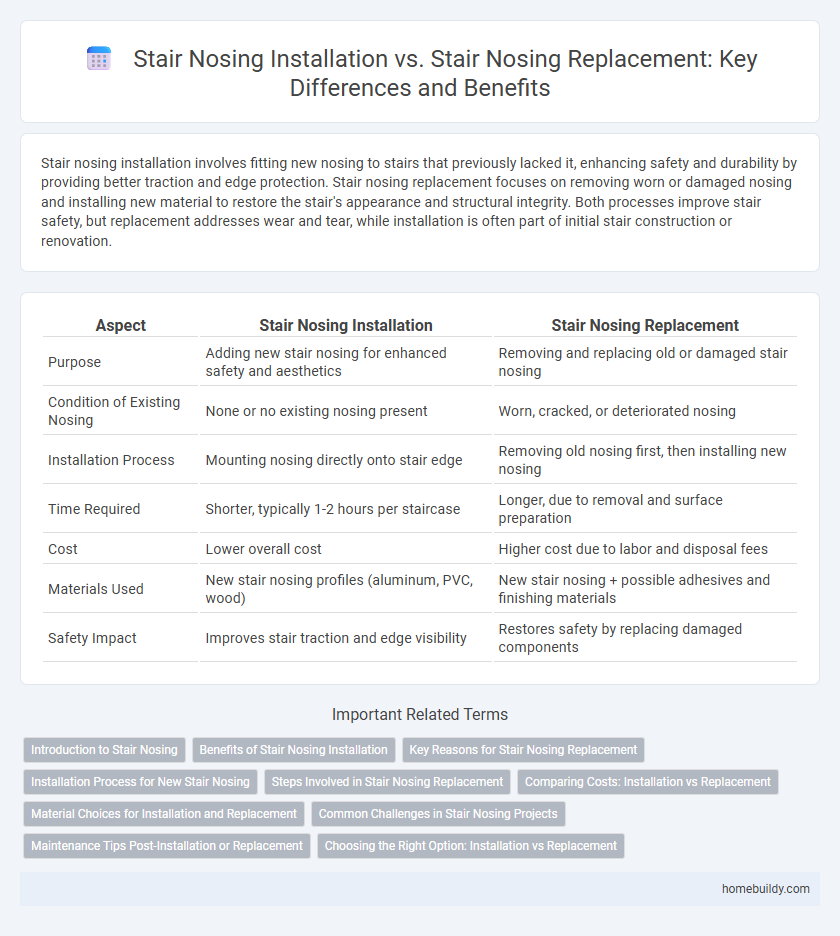Stair nosing installation involves fitting new nosing to stairs that previously lacked it, enhancing safety and durability by providing better traction and edge protection. Stair nosing replacement focuses on removing worn or damaged nosing and installing new material to restore the stair's appearance and structural integrity. Both processes improve stair safety, but replacement addresses wear and tear, while installation is often part of initial stair construction or renovation.
Table of Comparison
| Aspect | Stair Nosing Installation | Stair Nosing Replacement |
|---|---|---|
| Purpose | Adding new stair nosing for enhanced safety and aesthetics | Removing and replacing old or damaged stair nosing |
| Condition of Existing Nosing | None or no existing nosing present | Worn, cracked, or deteriorated nosing |
| Installation Process | Mounting nosing directly onto stair edge | Removing old nosing first, then installing new nosing |
| Time Required | Shorter, typically 1-2 hours per staircase | Longer, due to removal and surface preparation |
| Cost | Lower overall cost | Higher cost due to labor and disposal fees |
| Materials Used | New stair nosing profiles (aluminum, PVC, wood) | New stair nosing + possible adhesives and finishing materials |
| Safety Impact | Improves stair traction and edge visibility | Restores safety by replacing damaged components |
Introduction to Stair Nosing
Stair nosing enhances safety by providing a non-slip edge on each step, reducing the risk of falls and wear on stair edges. Installation involves fitting new nosing on stairs without prior wear, while replacement requires removing old, damaged nosing before applying the new one. Proper stair nosing ensures durability, visibility, and compliance with building safety standards.
Benefits of Stair Nosing Installation
Stair nosing installation enhances safety by providing improved traction and visibility on stair edges, reducing the risk of slips and falls in both residential and commercial settings. It protects the stair tread from wear and damage, extending the lifespan of the staircase while maintaining aesthetic appeal. Compared to stair nosing replacement, installation is often more cost-effective and less time-consuming, offering immediate safety improvements without the need for complete stair repairs.
Key Reasons for Stair Nosing Replacement
Stair nosing replacement is essential when the existing nosing shows signs of significant wear, damage, or safety hazards such as cracks, looseness, or loss of anti-slip properties. Unlike installation, which applies a new protective edge to stairs, replacement restores structural integrity and ensures compliance with updated safety codes and standards. Key reasons for stair nosing replacement include enhanced durability, improved traction to prevent slips and falls, and maintaining the aesthetic appeal of staircases in both residential and commercial buildings.
Installation Process for New Stair Nosing
Stair nosing installation involves securely attaching new nosing profiles to the stair edges to enhance safety and durability, typically requiring surface preparation, precise measurements, and compatible adhesive or mechanical fasteners. Proper installation ensures optimal slip resistance and extends the life of the stair tread by protecting against wear and damage. Selecting materials such as aluminum, PVC, or rubber nosing impacts both the complexity of the installation process and the overall stair performance.
Steps Involved in Stair Nosing Replacement
Stair nosing replacement involves carefully removing the existing nosing, cleaning the stair surface, and preparing it for the new installation. Precision in aligning the new stair nosing with the stair edge ensures safety and durability, often requiring adhesive application and mechanical fastening. Final steps include verifying secure attachment and checking for any gaps or unevenness to prevent trip hazards and extend the lifespan of the stairs.
Comparing Costs: Installation vs Replacement
Stair nosing installation typically involves lower upfront costs, ranging from $5 to $15 per linear foot, compared to stair nosing replacement, which can cost $20 to $50 per linear foot due to additional labor and removal of old materials. Installation requires precise measurements and material selection to enhance safety and durability, while replacement often addresses wear and damage, increasing expenses. Choosing between installation and replacement depends on stair condition and budget constraints, with replacement offering long-term benefits despite higher initial costs.
Material Choices for Installation and Replacement
Stair nosing installation often incorporates durable materials such as aluminum, vinyl, or rubber designed for new construction or major renovations, ensuring long-lasting protection and slip resistance. Stair nosing replacement typically prioritizes matching the existing material--wood, metal, or composite--to maintain aesthetic consistency and structural integrity while addressing wear or damage. Selecting the appropriate material for either installation or replacement directly impacts the safety, durability, and visual appeal of staircases in both residential and commercial settings.
Common Challenges in Stair Nosing Projects
Stair nosing installation often faces challenges such as securing proper adhesion on uneven surfaces and ensuring precise alignment to prevent tripping hazards. Stair nosing replacement can be complicated by the removal of old adhesives and damage to underlying materials, requiring careful surface preparation to maintain structural integrity. Both processes demand accurate measurements and durable materials to withstand heavy foot traffic and enhance stair safety.
Maintenance Tips Post-Installation or Replacement
Proper stair nosing maintenance after installation or replacement extends durability and ensures safety by regularly cleaning debris and inspecting for wear or damage. Applying recommended sealants or finishes protects the nosing material from moisture, corrosion, and heavy foot traffic. Periodic professional assessments help detect early signs of loosening or deterioration, enabling timely repairs that preserve stair integrity.
Choosing the Right Option: Installation vs Replacement
Choosing between stair nosing installation and replacement depends on the condition and material of the existing nosing. Installation is ideal for new construction or when upgrading to more durable materials like aluminum or rubber, enhancing safety and durability. Replacement is necessary when the stair nosing shows significant wear, damage, or fails to comply with current building codes, ensuring optimal slip resistance and structural integrity.
Stair nosing installation vs stair nosing replacement Infographic

 homebuildy.com
homebuildy.com